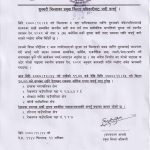Diseases in Wheat – Identification & Control Measures

INTRODUCTION
Wheat (Triticum aestivum L.) is one of the major cereal crops and ranks third positions in Nepal in terms of cultivated area and total production. It contributes more calories (20%) and more protein to the world diet than any other food crops and the gluten protein are very essential for baked products. The nutritional value it contains: carbohydrate 53% to 74%, protein 11% to 20%, fat 2%, minerals & vitamins and also higher amount of amino acids: thiamin and niacin.
Wheat crop has many benefits in human health and other purpose like livestock feed, beverage production, product diversification and straw for roofing and bedding material, mushroom cultivation, etc. the two economically important species T. aestivum(99%) and T. durum are cultivated in Nepal. In 2076/77, the area under cultivation was 707505 ha with a productivity of 3089kg/ha. But it is not sufficient for all of us, so large quantity of wheat is imported and one of the reason for the low yield is the inadequate of pest and disease management.
IDENTIFY AND CONTROL OF DISEASES:
Pests and diseases causes average 15% reduction in the yield, which vary up to high level in severe cases. Planting the resistant variety is the simplest and the most cost effective management of diseases. The some common pests and diseases occurring in wheat are discussed below:
1) LEAF BLIGHT:
Cause: By a fungus Alternaria triticina, major losses can results when susceptible cultivars are grown.
Symptoms: Small, chlorotic, oval or elliptical shaped lesions appear and as they enlarge, these lesions become irregular in shape. Infection usually starts on the lower leaves, but symptoms can be found on all plant parts. High humidity or irrigation, as well as warmer temperatures (20′ to 25’C) favor infection and disease development.
Management:
- Crop rotation at least one year out of wheat is the best option for controlling it.
- In addition, there are many resistant varieties available.
2) BROWN RUST/STRIPE RUST
Caused: By Puccinia recondite
Symptoms: The pustules are circular or slightly elliptical, smaller than those of stem rust. Infection sites primarily are found on the upper surfaces of leaves and leaf sheaths. The disease can develop rapidly when free moisture is available and temperatures are near 20°C.
Management:
- The most effective method of controlling rusts is to plant resistant varieties of wheat
- destroying alternate hosts
- applications of appropriate protective fungicides
- Growing wheat varieties that mature early.
3) YELLOW RUST/STRIPE RUST
Cause: By Puccinia striiformis
Symptoms: Infected wheat leaves develop long, narrow stripes, usually about 1/16 of an inch wide and irregular in length, of yellowish-orange pustules. Stem rust spores are lighter in color than those of leaf and stem rust.
Management:
- The most effective control method for stripe rust in wheat is to plant resistant varieties eg: Tilottama, Danfe, Bhrikutu, Gautam, Dhaulagiri, etc.
- Cultural practices also can help decrease disease incidences.
- Avoid early planting of winter wheat to reduce this risk as well.
4] BLACK RUST/ STEM RUST
Cause: By Puccinia graminis, the most damaging of all rusts capable of causing complete crop loss.
Symptoms: Fruiting bodies (uredinia) develop on diseased leaf sheaths, stems, spikes and occasionally on leaves as well.
Management: cultivating resistant varieties like Tilotamma, Danfe, Gaura, Dhaulagiri, etc.
5) LOOSE SMUT( Ustilago tritici)
Cause: Loose smut is a seed and wind-borne fungal disease. The pathogen survives in the wheat seed until germination and then grows up the shoot and infects the head. Yield loss is in direct proportion to the number of smutted head present.
Symptoms: Brown to black fungal spore masses develop in the diseased heads of the plants. The membrane ruptures during flowering and smut spores are dispersed leaving only the dark, bare rachis.
Management:
- It is not possible to visibly tell the difference between infected seed and healthy seed.
- Plant high quality, certified seed treated with an effective fungicide.
6) STINKING SMUT/ HILL or COMMON BUNT
Cause: By Tilletia foetida and T. caries .Common bunt and stinking smut are most commonly seed-borne diseases, but they can be soilborne and wind-borne as well. Seeds become contaminated during harvest, when smut spores from diseased plants stick to healthy kernels.
Symptoms: The symptoms of common bunt and stinking smut generally are not apparent until heading. Diseased plants may be stunted, and bunted heads may be a darker color of green and may stay green longer than normal plants . Heads of infected plants may also be smaller and their numbers reduced.
Management: Stinking smut and common bunt are controlled through seed certification and seed treatment.
7) POWDERY MILDEW
Cause: By Erysiphe graminis, Factors that favor powdery mildew problems include mild temperatures (59-71°F or 15-22°C), high humidity (between 85 and 100 percent), dense stands, high nitrogen fertilization, and varietal susceptibility.
Symptoms: Symptoms of powdery mildew include patches of powdery white or grey fungal growth on leaves, stems, and heads . Infection usually occurs on the lowest leaves of plants first and eventually works its way up the plant. As plants mature, the fungus changes color, getting darker grey and brown.
Management:
- Growing resistant varieties is the easiest way to control powdery mildew.
- Utilize crop rotation
- Destroy volunteer wheat
- Use a balanced nitrogen fertilization program to reduce the likelihood of inoculum.
BESIDES THESE VIRUSES, OTHERS ARE:
- Wheat streak mosaic virus (WSMV)
- High plains virus(HPV)
- Triticum mosaic virus
- Ergot (Claviceps purpurea),etc.
CONCLUSION:
The annual data shows that diseases and pests are reducing the yield and quality of this staple crop anuually ;which is leading to scarce of food and difficulties in storage. The cultivation methods have also an influence of losses due to diseases, so the guidelines should be followed. And likewise many future threats may occur ,sowe sholud be alert for the upcoming danger with diseases resistant & verified seeds along with preventive measures in suitable time.
Writer: Puja Roka (Student, Bsc. Ag 2nd-semester IAAS Paklihawa Campus)

 एउटा यस्तो विषालु भ्यागुता, जसको मुल्य नै पर्छ ३ लाख, जान्नुहाेस्
एउटा यस्तो विषालु भ्यागुता, जसको मुल्य नै पर्छ ३ लाख, जान्नुहाेस्  भोलि र पर्सि बालबालिकालाई भिटामिन ए खुवाइदै
भोलि र पर्सि बालबालिकालाई भिटामिन ए खुवाइदै  खगराज अधिकारी गण्डकीको मुख्यमन्त्री नियुक्त
खगराज अधिकारी गण्डकीको मुख्यमन्त्री नियुक्त  सुनसरीमा दुवै पक्षबीच सहमति, कर्फ्यु खुकुलो हुदै
सुनसरीमा दुवै पक्षबीच सहमति, कर्फ्यु खुकुलो हुदै  स्टेफेनको शतकमा आयरल्याण्ड वोल्भ्सले नेपाल ए लाई दियो २८५ रनको लक्ष्य
स्टेफेनको शतकमा आयरल्याण्ड वोल्भ्सले नेपाल ए लाई दियो २८५ रनको लक्ष्य 


